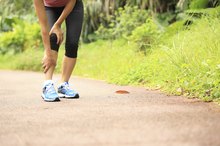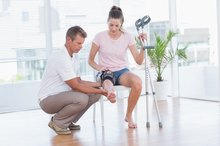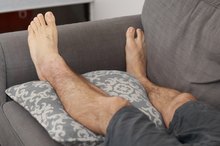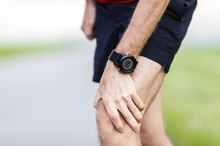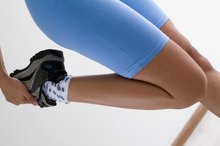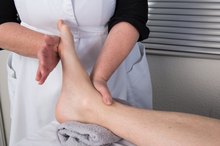How to Treat Shin Splints
Shin splints occur when stiff or overworked muscles and tendons in the lower leg begin to pull on the tibia bone and the connective tissues around the bone. Many athletes, particularly runners, experience this painful injury. You can heal most cases of shin splints with rest and other simple remedies. If you do not treat shin splints properly, the condition can get worse.
Rest
Don’t try to run or perform high-impact exercise with shin splints, even if you have an important game or race coming up. Running through the pain can make the condition worse. As soon as you feel pain in your shins, rest your legs and avoid high-impact exercise for one to two weeks. Continue exercising with low-impact activities, such as biking, swimming laps or performing water aerobics. Take the elevator instead of the stairs whenever you can, and walk with crutches if the pain prevents you from walking comfortably.
- Don’t try to run or perform high-impact exercise with shin splints, even if you have an important game or race coming up.
Home Remedies
What to Do for a Sore Calf From Hiking
Learn More
Icing the injured shins can relieve the pain and help them to heal, according to the American Academy of Orthopaedic Surgeons. Place ice packs wrapped in paper towels over your shins for 20-minute periods. Ice your shins four to eight times every day until shin pain dissipates. Reduce swelling in your shins by elevating your lower legs. Elevate your legs while you sleep for one or two nights. While your shins heal, you can relieve pain with over-the-counter medications, such as aspirin or ibuprofen.
- Icing the injured shins can relieve the pain and help them to heal, according to the American Academy of Orthopaedic Surgeons.
- Elevate your legs while you sleep for one or two nights.
Remove Cause
Avoid aggravating your shin splints when you resume normal exercise and prevent future occurrences. Replace worn out running shoes, or consider adding insoles or arch supports to make your shoes more supportive and comfortable. When you run long distances, opt for soft running trails instead of asphalt or pavement. Alternate between high-impact exercises and low-impact exercises to give your legs a break. Regularly stretch your lower leg muscles -- including the calf muscles at the back of the leg and the tibialis anterior at the front -- to increase their resistance to strain. Strengthen your lower-leg muscles with heel raises and toe raises so those muscles will absorb stress more effectively.
- Avoid aggravating your shin splints when you resume normal exercise and prevent future occurrences.
Related Articles
References
- The Stretching Institute: Shin Splints and Shin Splints Treatment
- MedlinePlus: Shin Splints -- Self-Care
- American Academy of Orthopaedic Surgeons: Shin Splints
- Summit Medical Group: Shin Pain (Shin Splints) Exercises
- Winkelmann ZK, Anderson D, Games KE, Eberman LE. Risk factors for medial tibial stress syndrome in active individuals: An evidence-based review. J Athl Train. 2016;51(12):1049-1052. doi:10.4085/1062-6050-51.12.13
- Pietrzak M. Diagnosis and management of acute medial tibial stress syndrome in a 15 year old female surf life-saving competitor. Int J Sports Phys Ther. 2014;9(4):525–539.
- Galbraith RM, Lavallee ME. Medial tibial stress syndrome: Conservative treatment options. Curr Rev Musculoskelet Med. 2009;2(3):127-133. doi:10.1007/s12178-009-9055-6
- Reinking MF. Exercise related leg pain (ERLP): A review of the literature. N Am J Sports Phys Ther. 2007;2(3):170-180.
- Nielsen RO, Buist I, Sørensen H, Lind M, Rasmussen S. Training errors and running related injuries: A systematic review. Int J Sports Phys Ther. 2012;7(1):58–75.
- Alaia MJ, Fischer SJ. Shin Splints. OrthoInfo. American Academy of Orthopaedic Surgeons. Reviewed August 2019.
- Ma CB, Zieve D, Conaway B. Shin Splints - Self Care. MedlinePlus NIH. Reviewed November 5, 2018.
- Moen MH, Tol JL, Weir A, Steunebrink M, De Winter TC. Medial tibial stress syndrome: A critical review. Sports Med. 2009;39(7):523-46. doi:10.2165/00007256-200939070-00002
- Reshef N, Guelich DR. Medial tibial stress syndrome. Clin Sports Med. 2012;31(2):273-90. doi:10.1016/j.csm.2011.09.008
Writer Bio
Lisa Porter began writing professionally in 2009. She writes for various websites and has a Bachelor of Arts in English literature.
